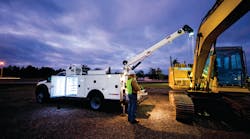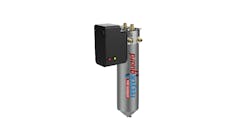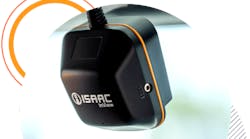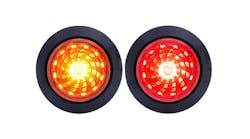Taking care of a truck also means performing proper routine maintenance on its body. If a truck is sidelined because of costly unexpected problems with its body, uptime is diminished, operational expenses go up and customers are inconvenienced.
Consequently, preventive maintenance ought to be as much a priority for truck bodies and its equipment as it is for power units, advises Terry Cook, product manager of commercial products at Iowa Mold Tooling Co. (IMT), a leading manufacturer of service vehicles and material handling systems. "It is worth the investment."
The type of body and vehicle application will dictate what maintenance needs to be performed and how often.
Consider service/utility trucks, by way of example. A well-run equipment fleet needs well-maintained service/utility trucks in order to keep its equipment up and running earning money.
All too often, because there are very few obvious moving parts and systems on the average service/utility body, maintenance tends to get overlooked, note officials with Original Seyller Bodies, a company specializing in building custom bodies for service trucks, lube trucks, harvesters and slicklines. A good inspection program is the key to keeping these bodies and their equipment clean, safe and available.
Inspecting a service/utility body should be part of the regular vehicle service program, they say, as "overall appearance and condition can tell you a lot. Is the body sitting squarely on the chassis? Does it sit higher in the front or rear? Are any of the doors sagging or not fitting properly? How does the finish paint look? Are all of the required lights on the unit and working?"
In maintaining service/utility trucks, the truck body and its components (crane, air compressor, liftgates, lubrication systems, reels, etc.) must be inspected and serviced on a regular basis, says Cook. Each of these has its own checklist of items requiring routine inspection and service.
BODY
IMT recommends that service bodies be given a walk-around inspection at least weekly, if not daily, keeping any eye out for any hydraulic leaks, broken transportation/safety lights and cracks in the body's structure.
If a hydraulic leak goes unnoticed, it could potentially cause a catastrophic failure and dump all the system oil, Cook says. If a leak is spotted, it should be corrected as soon as possible, add Original Seyller Bodies officials.
In addition, both IMT and Original Seyller officials recommend taking time to check under the body to ensure there isn't any hydraulic plumbing or electrical wiring hanging low or dragging, and inspecting electrical components and wiring. Any issues discovered need to be immediately corrected.
The underside of the body should also be cleaned and checked for loose mounting bolts, cracked members, rust and structural deformation, the officials urge. If the unit is equipped with a crane or lifting device, particular attention should be paid to the mounting structure.
"Not keeping the service body clean can lead to unsafe working conditions and prevent technicians and operators from noticing potential maintenance problems," says Cook. "The dirtier the truck, the less likely you are to see any problems.
"If you keep it clean and routinely monitor the truck, typically you can get any problems with the body rectified quickly and prevent future problems."
CRANE
The crane is the most intricate component of a service/utility truck, points out Cook, and offers the following recommendations for inspection and maintenance.
Daily. There are a variety of service-crane inspections that must be done daily, including checking:
- All safety devices for proper operation.
- Controls for leaks, cracks and proper operation of all functions.
- Hydraulic system (hoses, tubes, fittings, etc.) for leakage and proper oil level.
- The crane hook's safety latches and proper operation.
- The condition of wire rope.
- For loose parts or fasteners.
Monthly or after 100 hours of operation, whichever comes first. Inspections include:
- Cylinders for leakage at the rod, fittings and welds, as well as for damage to rod and case.
- Holding valves for proper operation.
- Control valves for leaks at the fittings and between stations, and control valve linkages for wear, smoothness of operation and tightness of fasteners.
- Electrical systems for presence of dirt, moisture and frayed wires.
Every three or four months or 300 hours of operation, whichever comes first. Inspections include:
- Wear pads for general condition.
- Rotation bearing for proper torque of all accessible mounting bolts.
- Base mounting bolts for proper torque.
- Crane structural components (base, stabilizers, mast, inner boom, outer boom, extensions, jib booms and extensions) for deformation, cracks and corrosion.
Yearly or every 1,200 hours, whichever comes first. Services include:
- Changing hydraulic fluid.
- Calibrating control and safety valves for correct pressure and relief valve settings.
- Checking all valves to ensure they maintain the correct settings.
- Inspecting the rotation drive system for proper backlash clearance and abnormal wear, deformation and cracks.
It's important that service technicians follow the maintenance schedule in their manufacturer's service manual, which is typically set by the calendar year, stresses Cook. Cranes working in high-usage environments should receive maintenance based on the number of service hours they have operated.
WIRE ROPE AND HOOK
An important part of regular crane inspection involves checking the wire rope and hook frequently, Cook says.
"There are a number of characteristics to look for in your wire rope, some requiring immediate replacement and some indicating the rope should be monitored very closely," he says. "Corrosion might be cause for replacement and at the very least noted and carefully monitored.
Other reasons a wire rope might need to be replaced include:
- Three broken wires in one strand or a total of six broken wires.
- Flat spots on the outer wires.
- A decrease in diameter which indicates a core failure.
- Distortion, such as kinking, crushing or birdcaging (wire rope strands are forcibly untwisted and become spread outward).
Hooks also are a critical component and must be monitored closely for safety reasons, which is why they are a daily inspection item, says Cook. A deficient hook must be removed from service right away.
Hooks should be removed and repaired if any of the following conditions are present:
- Bending or twisting.
- Wear that exceeds 10 percent of the original dimension.
- Cracks, nicks or gouges.
- Deformed or malfunctioning latch.
COMPRESSOR
Service/utility trucks come equipped with either a reciprocating air compressor or rotary screw air compressor. No matter which model of air compressor a truck is outfitted with, the airend (compressor screw element) oil level should be checked daily, says Cook.
Technicians should also make sure the air tanks have been drained of all condensation before using the compressor. Upon starting the unit, technicians should observe that it is building pressure and inspect the fitting and air lines for any leaks.
Oil should be changed in a compressor every 250 service hours or every three months, whichever comes first, he advises.
IMPROPER MAINTENANCE
If all the components of a service/utility truck "are not properly maintained and serviced, the risk to technicians can be significant," warns Cook. "Poor maintenance can lead to catastrophic failures that can threaten the safety of the technician and others working in the immediate area.
"Additionally, when your service/utility truck is down due to mechanical problems, it impacts your bottom line."
Service truck owners are usually pretty good about keeping up on the chassis' preventive maintenance schedule, but they're often not as diligent about other components of the service body, such as the crane and air compressor, he notes.
"Because service trucks are often used for extended periods operating the hydraulic equipment but not moving, maintenance intervals are typically determined by hours of use rather than mileage. By including the hour meter readings for cranes and compressors in fleet maintenance tracking systems and comparing to recommended maintenance intervals, the equipment maintenance can be planned along with the chassis maintenance."




